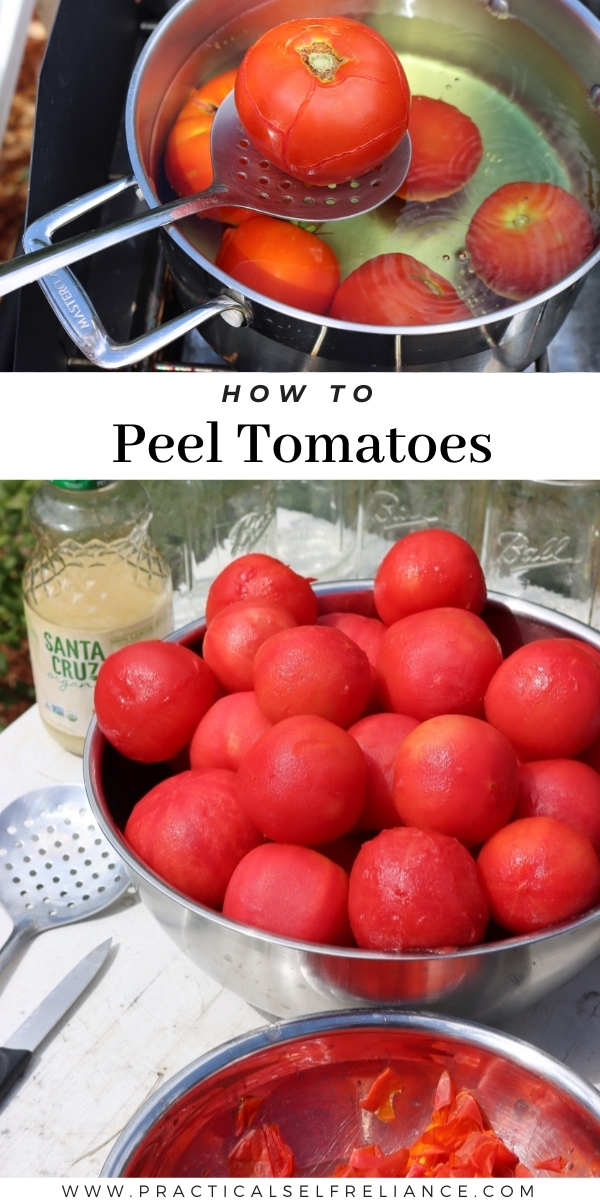Affiliate disclosure: This post may contain affiliate links. Please see our Privacy Policy.
Peeling tomatoes may seem daunting, but it’s actually quite simple with the right technique.
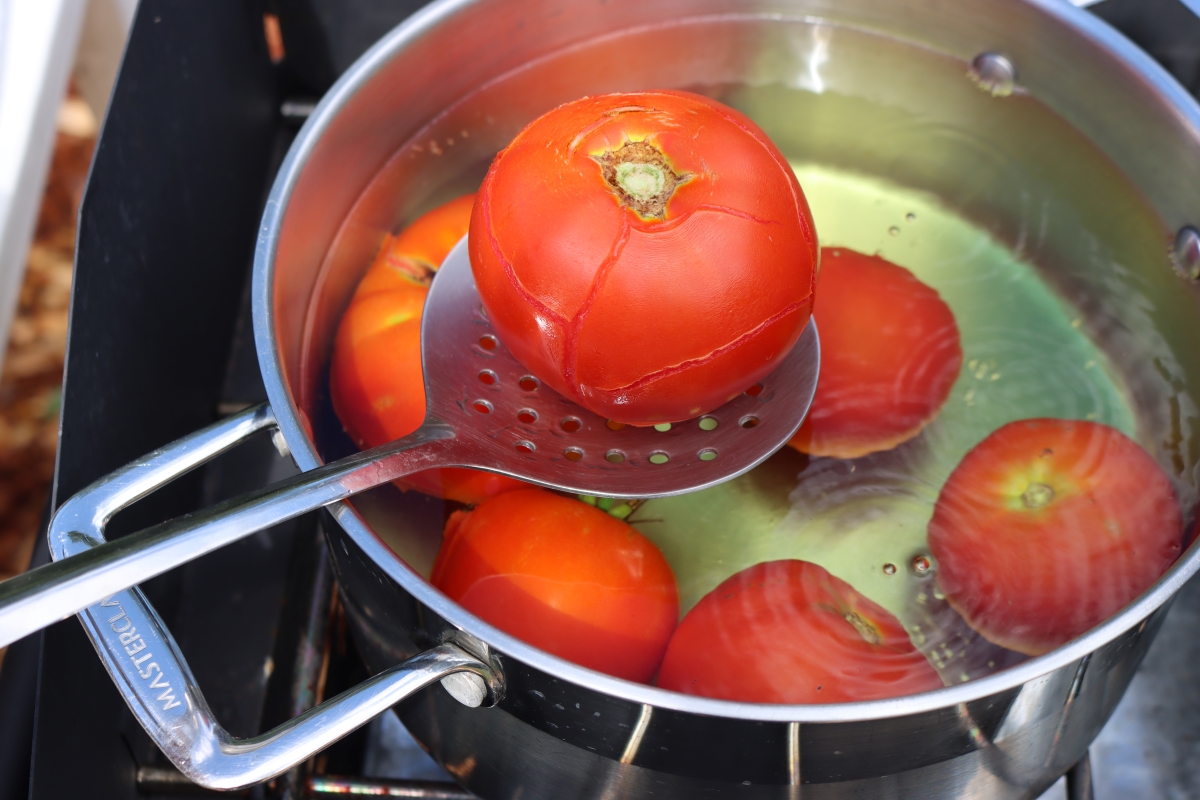
When most people hear peeling tomatoes, they imagine a very sharp knife and a lot of patience (as well as waste). In reality, the process is quite straightforward, and nothing like peeling carrots of potatoes. Put away your knife, that’s not the best way to peel tomatoes!
The simplest way to peel tomatoes is actually by blanching. Tomatoes are placed in boiling water for about 60 to 90 seconds, which flash cooks them right under the skin.
The skin will crack as the tomato flesh expands, and you’ll be able to slip the skins off with your fingers (once the tomatoes are cooled).
Since the blanching process is so quick, it only cooks about 1 mm of tomato under the skin, leaving a raw peeled tomato without much effort.
When to Peel Tomatoes
Tomato skins are fine on fresh tomatoes, but they need to be removed for many recipes. Chunks of peel are no good in a smooth tomato sauce, and they can sometimes give an unpleasant bitter taste to cooked dishes.
You’ll want to peel your tomatoes if the end goal is a perfectly smooth tomato purée or sauce, not the mention garden-fresh tomato juice and Bloody Marys.
More often than not, when I’m peeling tomatoes, it’s for all manner of tomato canning recipes.
If the skin isn’t removed before canning it will pop off during the canning process, sink to the bottom of the jars and the bitter flavor will steep into the skin-less tomatoes. Unlike other fruit (plums, for example) tomato skins don’t add anything of value to the taste or texture of the finished recipe, and can actually detract from both the flavor and texture.
When Not to Peel Tomatoes
You can skip the peeling process if the tomatoes being used have firm flesh and delicate skin.
Sometimes the tomato peel provides structural support — think sliced tomatoes in a sandwich, tomato wedges in a salad, or if you’re making stuffed tomatoes.
Keep the peel on if you’re roasting or dehydrating tomatoes, otherwise the tomatoes break apart and you’ll have a mess on your hands.
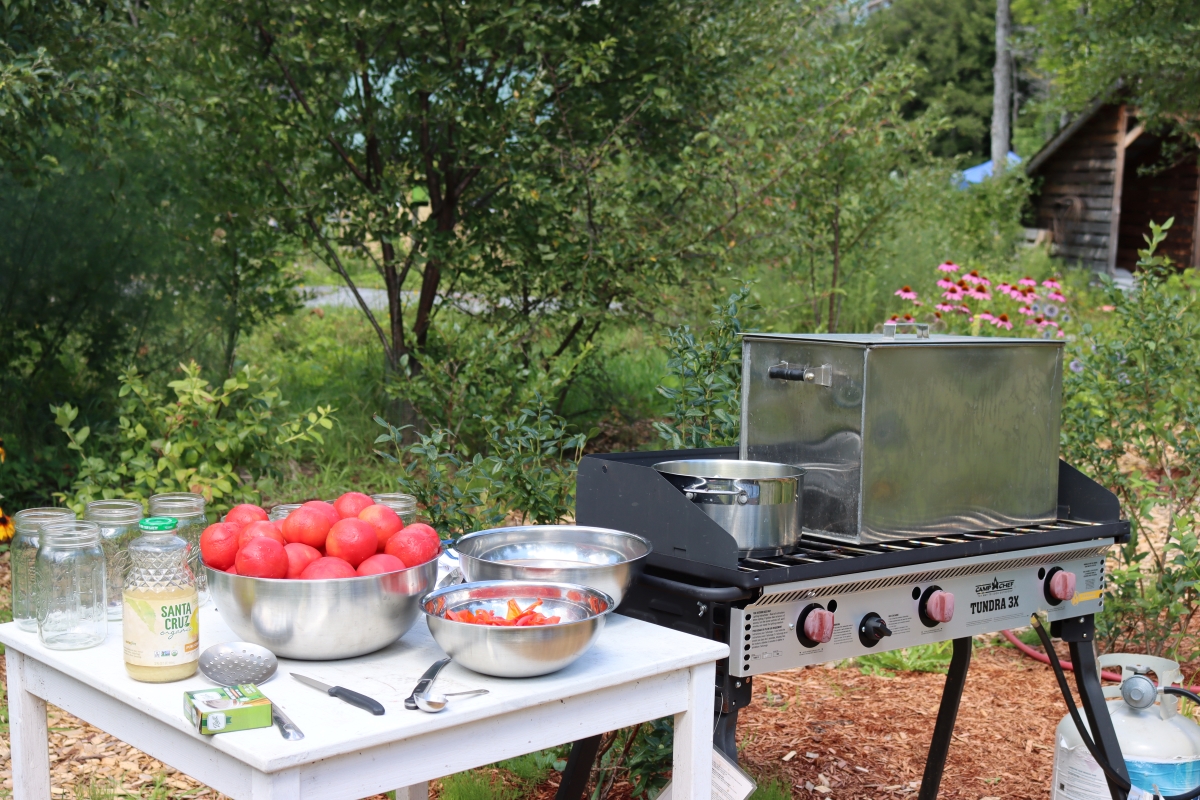
How to Peel Tomatoes
I use the “blanch and peel” method for peeling tomatoes because I can peel a whole bunch of tomatoes in a short amount of time with very little work on my part.
To get started, you’ll need:
- Tomatoes
- Stockpot filled about 2/3s of the way full with water
- Sharp paring knife
- Slotted spoon
- Large bowl filled with cold water
Bring the water in the stockpot to a boil.
While the water is heating up, cut a shallow “x” into the bottom of each tomato. This is optional, but it helps the skin separate faster, and may be necessary for stubborn tomato varieties. When I’m working with my favorite canning tomatoes, I skip this step because the skins tend to slip easily after a quick blanch.
Using the slotted spoon, lower a couple of tomatoes into the water. Leave plenty of room so that the boiling water can circulate around the tomatoes.
Let the water return to a boil and blanch the tomatoes for around 30 to 90 seconds, until the peel starts to crack.
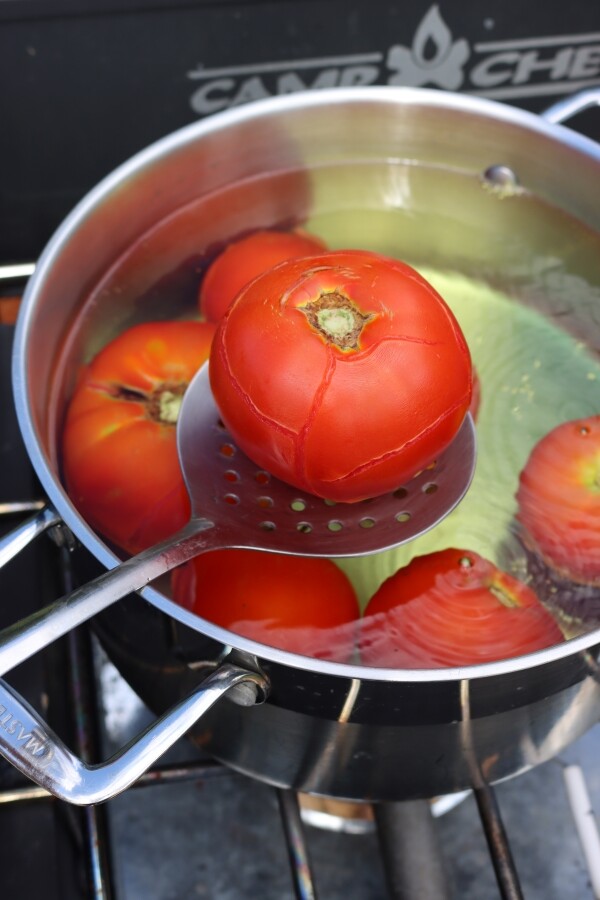
If you’ve sliced an “X” into the bottom of each tomato, you’ll see it curl up and away from the tomato flesh.
Use the slotted spoon to transfer the tomatoes into the bowl of cold water, this step is important because it stops the cooking process.
If you have a large batch of tomatoes to peel, you should change the water frequently so that it stays cold — you can also add ice to the bowl to keep the water temperature low.
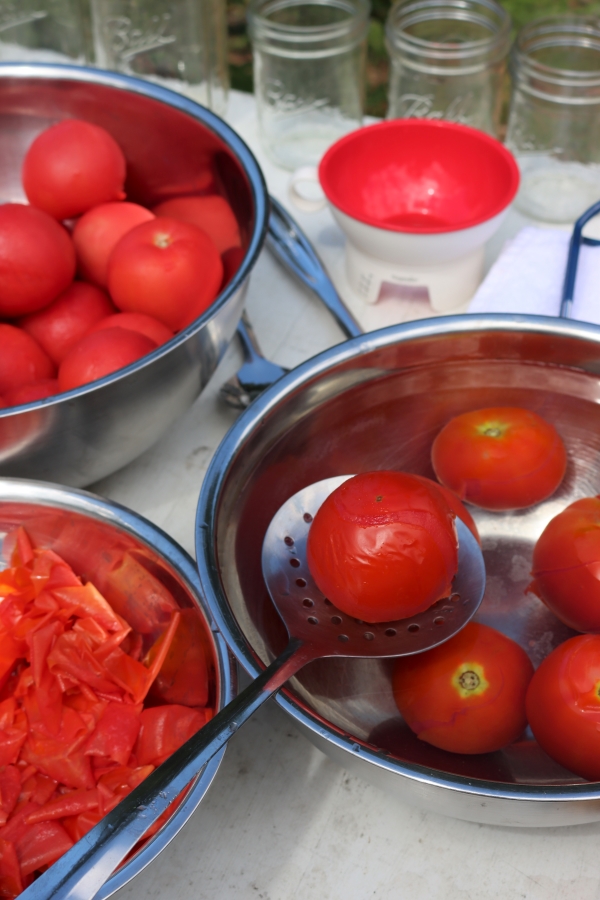
Using your fingers, pull the tomato skin away from the tomato flesh.
At this point the peeled tomatoes are ready to be canned in a hot water bath canner or pressure canner, or used right away in gazpacho, sauces, and anywhere else a smooth tomato texture is needed.
In this case, I’m peeling tomatoes in my outdoor canning kitchen, and my next step is canning whole tomatoes for wintertime meals.
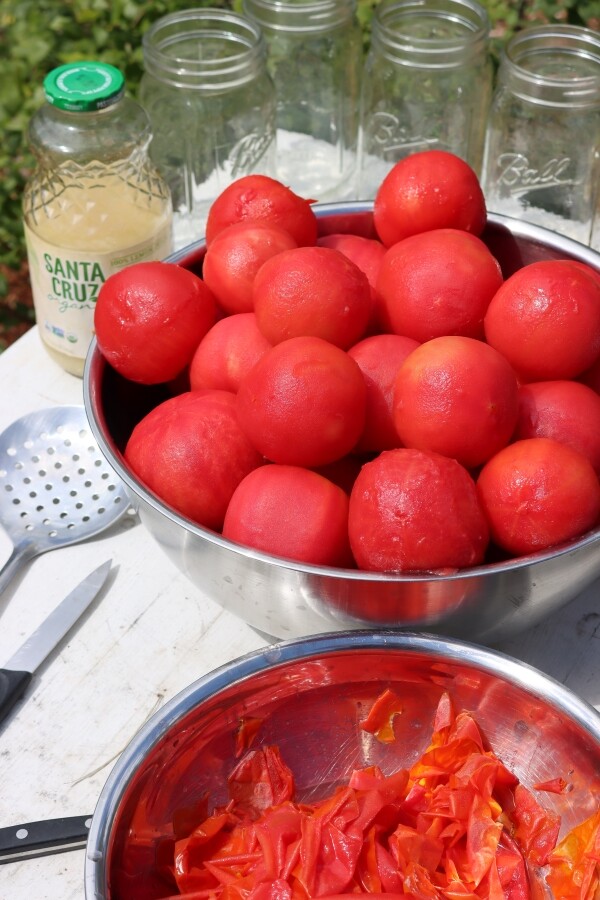
Using Tomato Peels
If you’ve never tried making your own tomato flakes or powder there’s no better time than after you’ve finished a peeling a big pile of tomatoes.
You can always save small amounts of tomato peels in the freezer and then dehydrate them in a large batch. After the tomato skins are dehydrated they can be finely ground into a powder or left as larger flakes. I use a spice grinder for a fine powder and a mortar and pestle for a more textured result.
Homemade tomato powder is delicious sprinkled on pizza or popcorn, stirred into marinades, and added to spice blends and rubs.
It can also be used to give a boost of flavor to out-of-season tomatoes, I especially love sprinkling onto roasted tomatoes as soon as I take them out of the oven.
To stretch the potent tomato flavor out even further, combine dried tomato powder with coarse salt, in my opinion there’s no better seasoning for egg dishes and grilled fish.
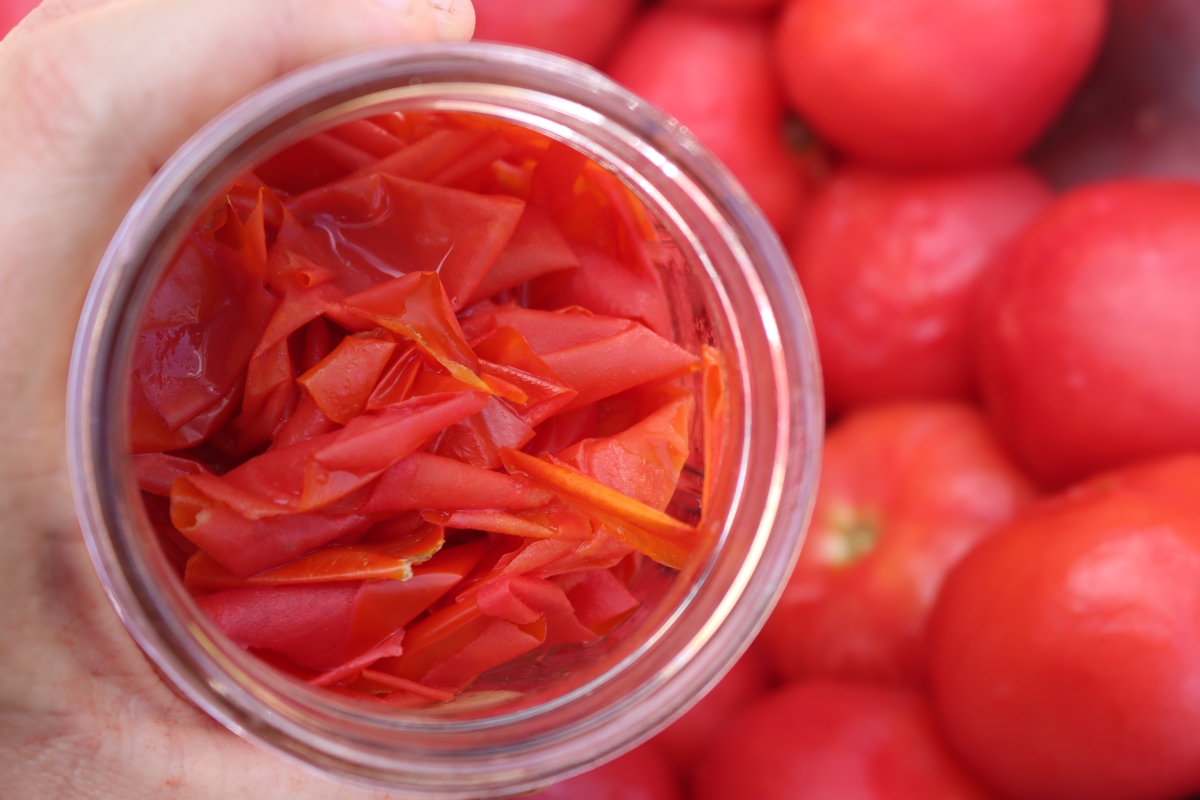
Coring Tomatoes
Tomato cores have an unpleasant texture so, although it’s an optional step, if you’ve gone to all the trouble of peeling the tomatoes you might as well commit to the process.
To core a tomato, simply insert the tip of a small paring knife into the space directly beside the core. With a twisting motion, cut around the core and remove the woody stem with the knife tip.
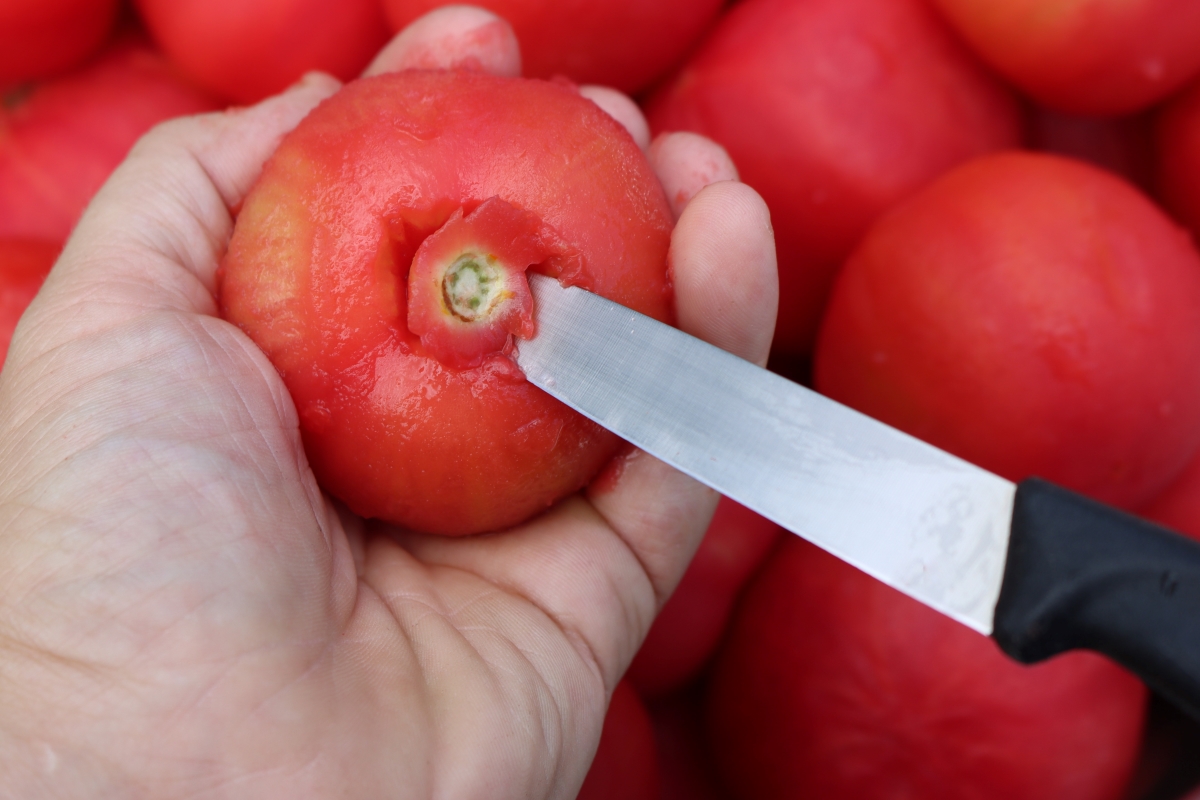
Seeding Tomatoes
Peeling tomatoes doesn’t always mean seeding tomatoes, but most recipes that require you to peel will also benefit from seeding.
You can easily remove the seeds from tomatoes by halving or quartering them and then squeezing out the seeds with your hands.
Use a teaspoon to scrape out any leftover seeds from hard-to-reach places. This technique is much easier if you’re using low seeded paste tomatoes, such as Roma tomatoes, because they have a low water content and smaller seed cavities.
Again, this step is optional, but can make a surprisingly big difference if you plan on making tomato sauce or juice.
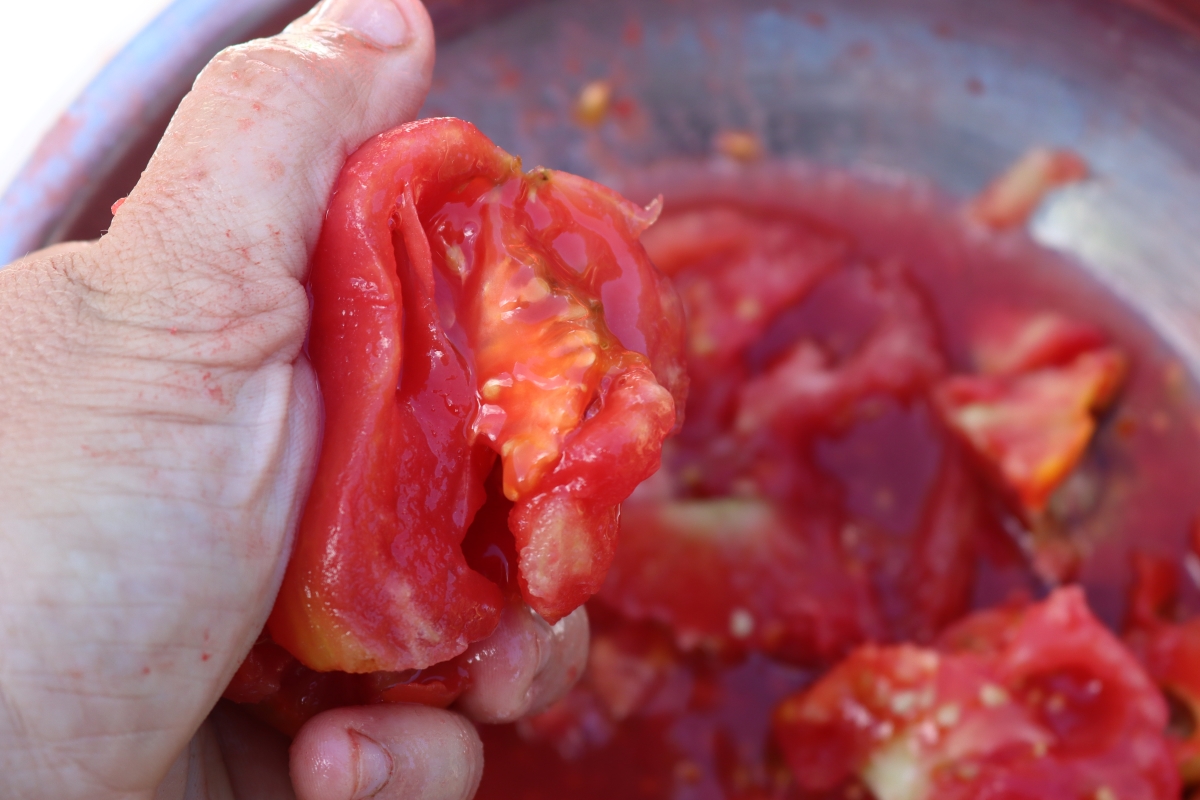
Other Ways to Peel Tomatoes
Beyond blanching, there are a couple of other methods for peeling tomatoes worth mentioning. They each have their pros and cons, and I still personally recommend the quick blanch method.
There may be times when that just won’t work for you, so I’m providing other options just in case.
Peeling Tomatoes by Freezing
The freezing method is a great way to peel frozen whole tomatoes, especially Roma tomatoes, if you have lots of storage room in your freezer. Only freeze ripe (or even over-ripe) tomatoes, as it won’t work well for green or under ripe tomatoes.
You can let them sit out on the counter for 2 to 3 days to ripen if they weren’t ripe when they were picked. (Personally, I’d just use them in green tomato recipes instead.)
Pop the tomatoes into the freezer whole, you don’t even need to wash them first if they’re from your own un-sprayed garden.
When you’re ready to use them, take out as many as you need from the freezer and pop them directly into a large bowl or clean sink filled with warm water for about 30 to 60 seconds. This will quickly thaw the tomato flesh right beneath the peel, while still leaving most of the tomato frozen solid.
The skin should slip off easily, leaving a frozen but peeled tomato behind.
The downside is that freezing changes the texture of tomatoes, and reduces their natural pectin content. The juice and flesh will separate as the tomato thaws, and it’ll be hard to make a cohesive sauce.
That’s why I recommend the blanching method, which leaves the tomatoes in more or less their original state, just peeled and ready to use.
Peeling Tomatoes by Fire Roasting
You can also roast tomatoes to remove the peels, this gives the tomato flesh a subtle smokey flavor that’s especially tasty in homemade roasted tomato salsa recipes.
Preheat the oven to 425 degrees F and halve the tomatoes lengthwise. Line a a rimmed baking sheet with parchment paper or a silicone baking mat and arrange the tomato halves cut-side down — make sure there’s ample space around each tomato half so the heat can circulate evenly.
Again, this technique works best with firm Roma tomatoes.
Roast for 30 to 35 minutes, or until the tomato skins begin to brown and blister in spots. Remove the tomatoes from the oven and let them sit for a few minutes until cool enough to handle and then pinch the skin off with your fingers.
This method cooks the tomatoes all the way through, which isn’t appropriate for every recipe. Still, it’s a good option if you’re cooking the peeled tomatoes anyway, and it adds a delightful smokey taste.
Other Tomato Processing Techniques
Peeling tomatoes by hand is really only necessary if you need whole or diced peeled tomatoes. For making sauce, there are better tools.
If you don’t need to keep the tomatoes whole, you can quickly process tomatoes using a food mill or, the old fashioned labor-intensive method, a chinois sieve.
A food mill will quickly separate tomato flesh from the peel, core and seeds, leaving you with a smooth batch of tomato pulp. That’s what I do when I’m making big batches of tomato sauce in the busy summer months.
Start by coarsely chopping the tomatoes, then cook them in a stock pot for about 10 to 15 minutes. This will break down their flesh, but more importantly, set the juice and pulp together. That will prevent the juice from separating from the finished sauce, leaving you with a smooth cohesive sauce without bothering to peel the tomatoes by hand.
You can also achieve a similar effect with a chinois sieve and a wooden pestle.
I find the chinois method works better if you only need to process a small number of tomatoes, and I’ll pull out my kitchenaid food mill for quickly working through larger batches. You can also get a hand crank food mill that’s very much like the kitchenaid version (and just as efficient), but works without electricity.
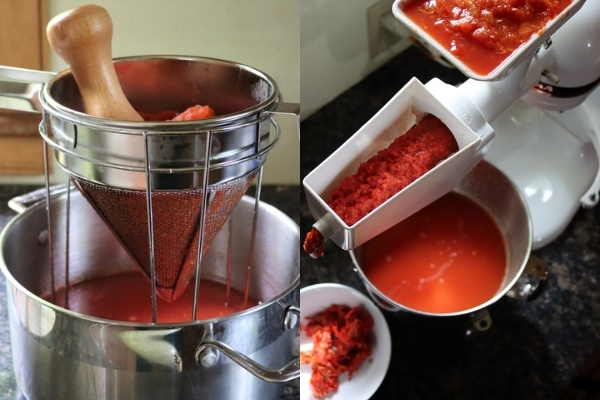
Using Peeled Tomatoes
Of course, you can use them in your favorite recipe, but I like to do them in big batches and preserve them by canning (or freezing), to save time later.
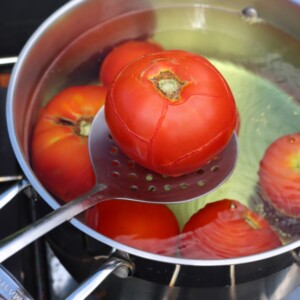
How to Peel Tomatoes
Ingredients
- Tomatoes
Instructions
- Fill a large stockpot two-thirds of the way with water.
- Bring the water to a boil.
- While the water is heating up, use a small paring knife to make a shallow "x" incision on the bottom of each tomato.
- Fill a large bowl or pot with cold water.
- Drop the tomatoes in the boiling water a couple at a time, allowing for plenty of space between the tomatoes.
- Allow the tomatoes to blanch for 30 to 60 seconds, just until the skin cracks and/or starts to lift from the tomato flesh.
- Remove tomatoes from the boiling water and immediately drop them in the cold water to halt the cooking. (Refresh the cold water as needed.)
- Continue working through the tomatoes until all have been blanched. Be sure to allow the water to return to a boil between batches.
- Peel the tomatoes using your fingers, setting aside the tomato skin if using for ground tomato powder. (If the skin won't slip easily, place the tomato back in the blanching water for another 30 seconds and repeat the process until the skin loosens.)
- Core and de-seed tomatoes if desired.
Ways to Preserve Tomatoes
Need a few ways to preserve a bumper crop of fresh tomatoes?
